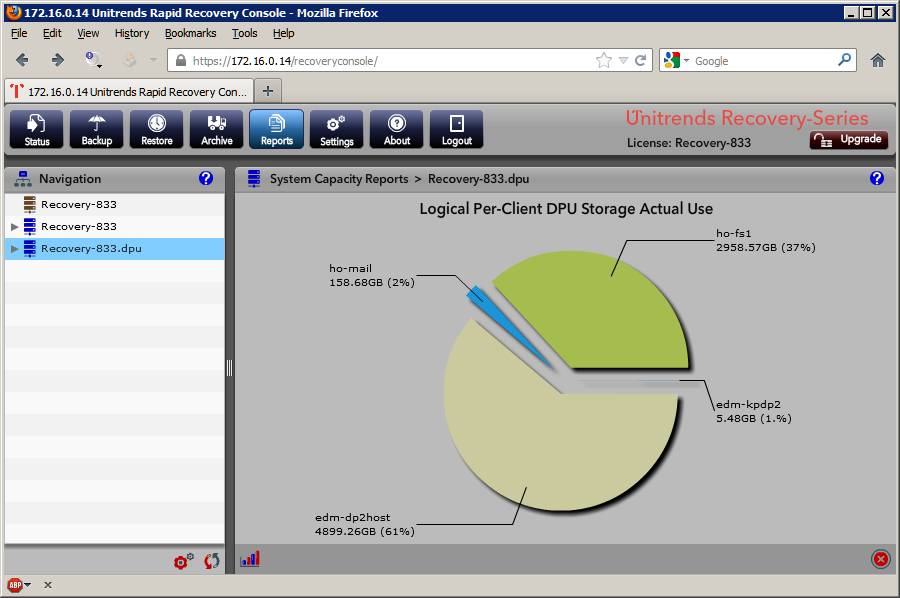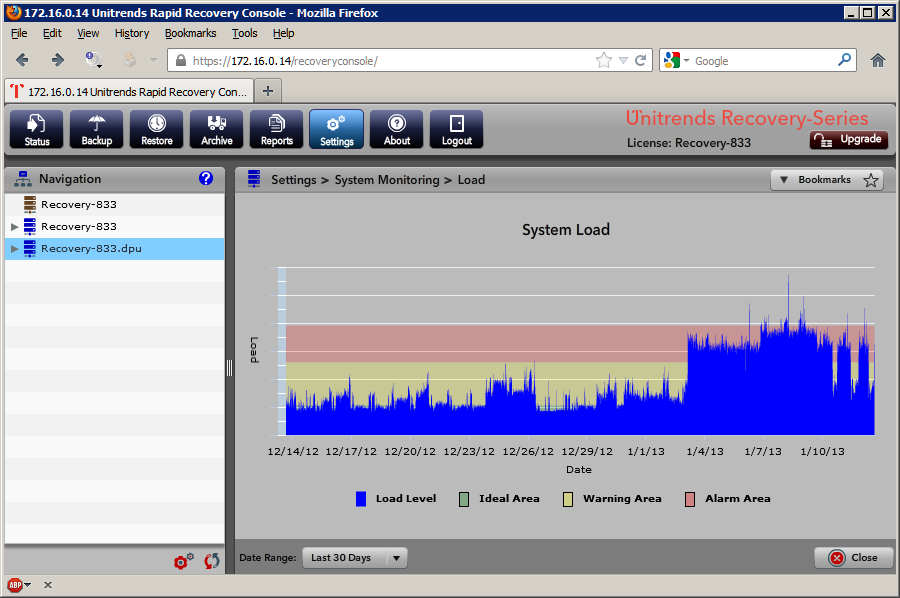Original URL: https://www.theregister.com/2013/02/07/unitrends_review/
Review: Unitrends backup appliances
Backing up, disrupting and... worth it?
Posted in Storage, 7th February 2013 09:03 GMT
Review In my experience, backup software sucks. Normally, I chalk that up to a lack of exposure to non-crap alternatives on my part. Talking to backup admins and doing the maths on the licensing leads me to believe my original assessment is correct; there are precious few backups applications and vendors that don't cause some form of significant angst among their userbase. While at Spiceworld, I voiced this opinion.
Unitrends stuck out for me among vendors at Spiceworld for the tenacity of their marketing folk. Along with other startups in the field, they're out to make a name for themselves - attempting to reach the "explosive growth" phase. They have a loyal core customer base, decent technology and a pricing structure that threatens to destabilise the market for incumbents.
Unitrends offers its backup software via two different routes: a virtual appliance and a physical one. The company sent me one of its backup appliances for review: a Recovery 833 designed to back up about 20TB worth of data. It has an MSRP of just under $50,000. I've also taken the time to play with its virtual appliance so that I can compare and contrast between the two offerings.
The software: What do you mean, easy-to-use interface?
The heart of Unitrends' offering is its software. Whether offered as part of a virtual appliance or a physical one, it is really the software that you end up paying for. Unitrends uses both agentful and agentless backup methods. This allows Unitrends to back up operating systems via operating system images, databases such as SQL, Microsoft Exchange and so forth by being application aware. It will also back up virtual machines, virtual hosts, as well as file storage. They do just about every kind of backup you can imagine, from standard differential and incremental through to vaulting, P2V/V2V/V2P and "incremental forever" protection. (Incremental forever is Unitrends marketing lingo for near-continuous data protection in which data backed up is never more than 15 minutes old.)
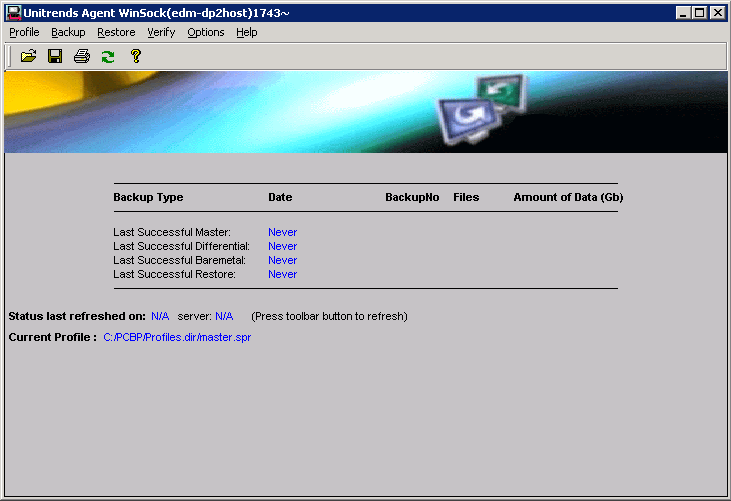
Unitrends agent software
Unitrends and I could have a very long conversation about our differences of opinion regarding an easy-to-use interface. Not being an enterprise backup admin, I personally found the Unitrends software to have a steep learning curve; it took me the better part of four days to figure out how to get the software to do everything I wanted it to do. I purposefully didn't use any of the tutorial videos before diving in to the software, as I wanted to get a feel for how intuitive it was out of the box. I did take a look after the fact, and the videos are actually quite good - if you start there, you'll be fine.
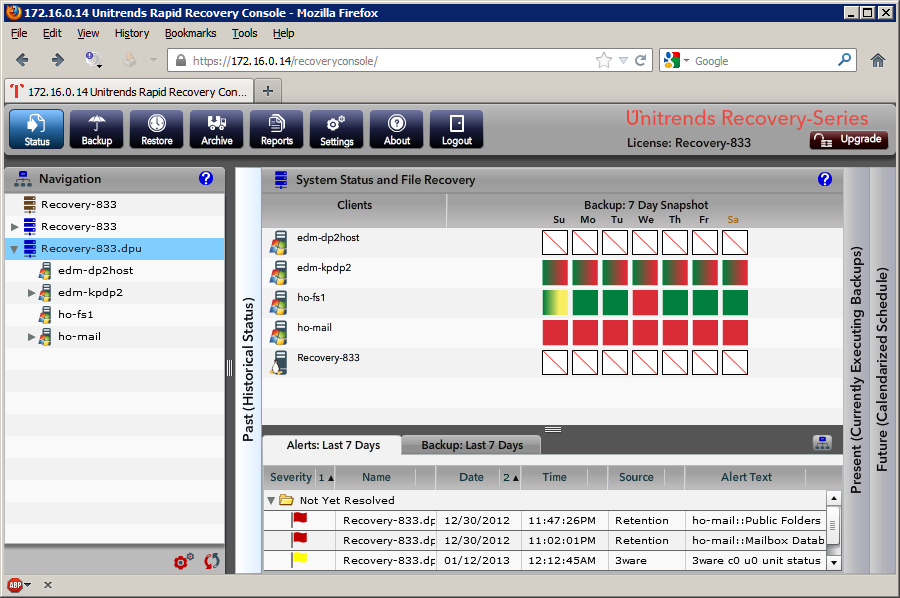
Unitrends Interface
I'm not a big fan of the agent software. I really like the fact that the Windows agents install themselves without requiring a system reboot, so they get a cookie there. I otherwise find the agents to be clunky, counterintuitive, and completely lacking in what I would consider to be pretty basic setup functionality. Ideally, when I install an agent on a system, I should either be prompted with a nice wizard to connect to the relevant backup server, there should be a button that scans the network for appropriate backup servers, or both.
Instead, there's some complicated process involving selecting the appropriate backup server, registering with it, going over to the server software to configure backups and triggering it from there. Fortunately, I can generally get away without having to use the agent at all.
Once over the initial learning curve, everything within the software is laid out quite logically and there are a number of interface elements I quite like. One that endears me is the repeated use of auto-generated charts and graphs.
You can easily identify your storage usage, deduplication impact, and more with a simple to understand visual reference: great for copying and pasting into a presentation with the pointy-haired boss.
I'm less impressed with the error handling within the application. If your backup encounters an error, a great deal of information about that error is recorded.
There is, however, no remediation information presented. This means your Google-fu must be strong.
Despite my grousing, Unitrends' offering is still significantly easier to use than any of the other enterprise backup software I've had opportunity to work with, the virtual appliances I played with (version 7) were easier to deploy than I would have expected. Once I figured out the underlying logic behind how things were laid out, it proved easier and more efficient than System Center Data Protection Manager, Tivoli Storage Manager, Symantec's NetBackup, or even my beloved Retrospect. It absolutely wrecks Appassure.
Why a physical appliance?
When I was first received the appliance, I wasn't particularly impressed. It is a stock-standard 2P Xeon E5520 with 48GB of RAM in a Chenbro RM31616 packed full of 3TB Seagate Barracuda 7200.14s, with 2x 1TB for the OS. It uses an LSI 9650SE RAID controller in provide RAID 6 + 1. 32TB of disks become roughly 20TB of usable space in a RAID 60 configuration. The other appliances on offer are rebadged Supermicro servers for enterprise level or a small Coolermaster for small businesses.
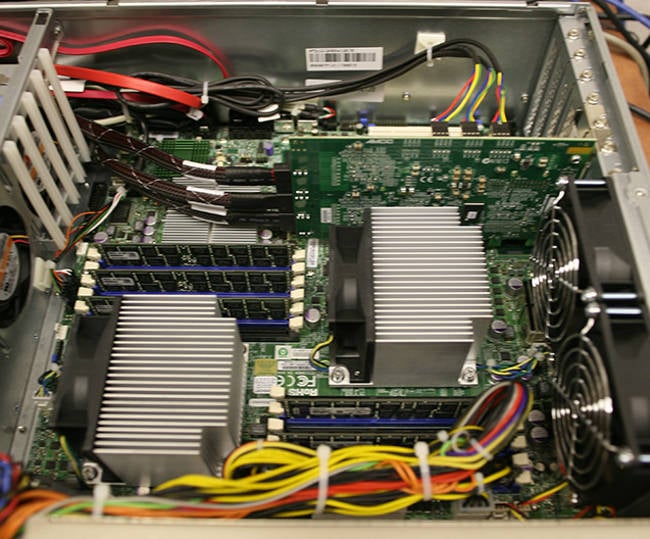
Unitrends appliance guts
So far, so very…me. Chenbro, Supermicro…I even built a line of Atom-powered CentOS routers that I stuffed into those same Coolermaster cases. I've made a living building solutions for clients out of nearly identical hardware configurations to what Unitrends is shifting here - $45K is a fantastic markup. While the target market for the physical appliance is certainly not folks who Whitebox their own servers, the software on the unit is not all that different from what's in the virtual appliance, so what gives?
Part of the reason for the seemingly high cost of the physical appliance is that the licensing that accompanies the physical appliance allows you to back up an unlimited number of systems (hosts, VMs or metal), applications, files, or what have you. So long as your backups fit on the Unitrends appliance, you're good. Bear in mind that the Unitrends appliance has robust deduplication, so you'll get more on there than you think.
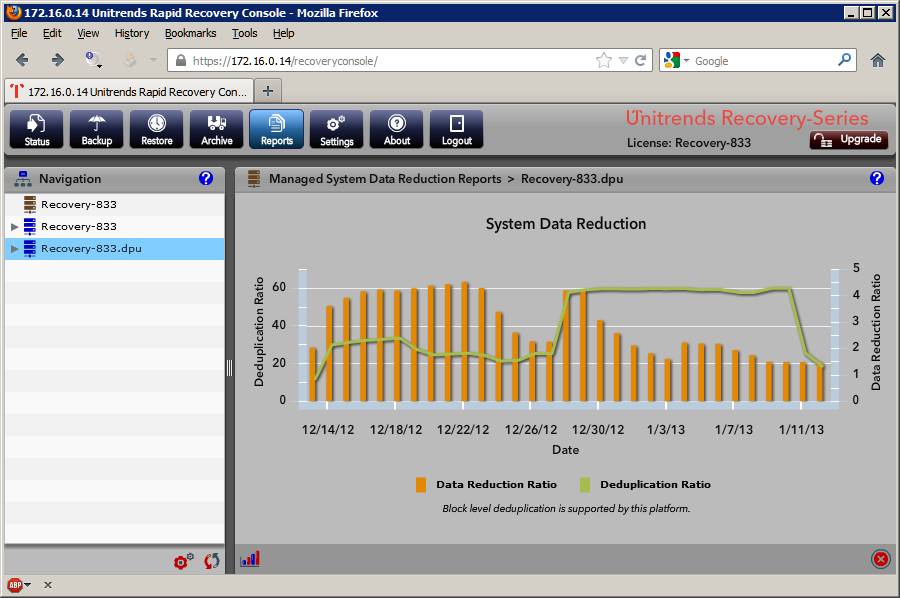
Unitrends deduplication graph
Another important feature – perhaps the important feature – of the physical appliance versus the virtual one is what Unitrends calls "instant recovery with failover virtualisation." The short version of this is that Unitrends installs a hypervisor on its backup appliance and allows you to instantly fire up any failed system's bare metal image (or VM image) as a VM hosted off the appliance.
If a VMware host in your environment fails, the Unitrends appliance will make all of the VMs that were hosted on that machine available to a new VMware host as a virtual storage provider. These operating systems continue to be backed up by the appliance while operating in this mode. Additionally Unitrends offers the ability to restore a failed system to dissimilar bare metal. This only officially supports Windows.
The biggest hit to the system seems to be large quantities of small files. Backing up 5TB with over 3m files in ~375k folders took about a week. (The transfer time was due entirely to the fact that my storage server is slow and heavily loaded; the Unitrends can tank 5TB far quicker.)
Throughout the entire week, the Unitrends appliance's system was in the red - admittedly caused, I suspect, by trying to deduplicate ~2.8m jpegs while it was updating its internal database.
Unitrends offers some attractive pricing solutions, including licence per host (small number of fat hosts with many virtual machines) and licence per terabyte of backed up data (lots of hosts, not many VMs). It also offers a free version that will protect 4 VMs and an NFR version for VMware or Microsoft Certified Processionals. The NFR version protects two sockets across up to two physical servers as well as two application servers for as many VMs or files as you can handle.
Because I know that not everyone who reads The Register has one of these certifications, I've talked Unitrends into widening its NFR licence to all Reg readers. Simply use the code Register2013 and download your NFR version of the Unitrends appliance. No software is right for everyone, nor can a review cover every aspect of what matters to all readers. In Unitrends' case at least, you now have the chance to check it out. ®
